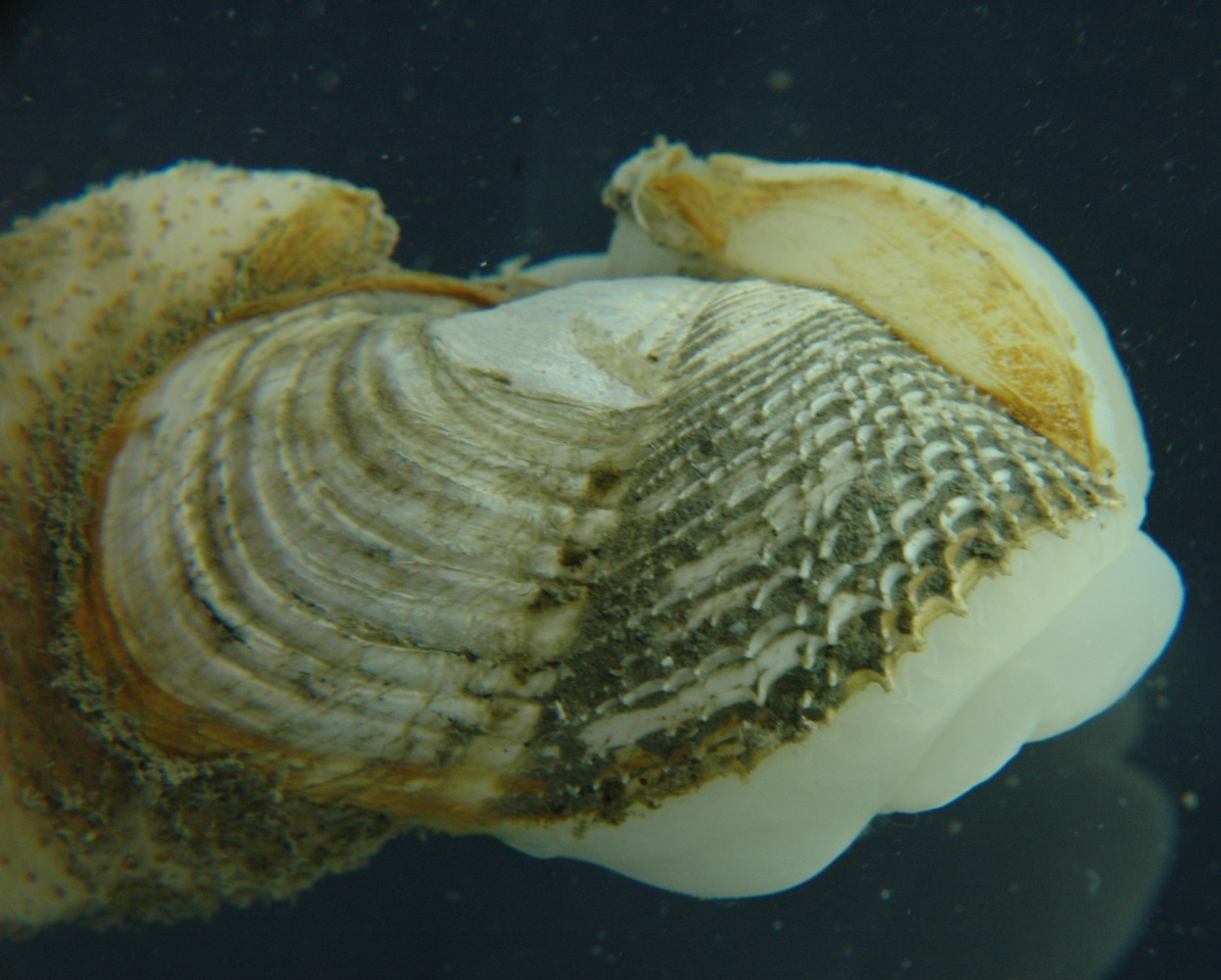Zirfaea pilsbryi Lowe, 1931Common name(s): Rough piddock, Pilsbry piddock, Pacific rough piddock |
|
| Synonyms: Zirphaea gabbi, Zirphaea pilsbryii |  |
| Phylum Mollusca
Class Bivalvia Subclass Heterodonta Order Myoida Suborder Pholadina Family Pholadidae |
|
| Zirfaea pilsbryi found burrowing in hard mud in Fidalgo Harbor under the railroad trestle.. Total length 7 cm, shell length 4 cm. The anterior of the shell and the white protruding foot are on the left. The siphons are on the right. | |
| (Photo by: Dave Cowles, August 2006) | |
How to Distinguish from Similar Species: Barnea subtruncata does not have the anterior and posterior portions of the valves separated by a groove. Netastoma rostrata has a calcified siphonoplax and lacks myophores, plus the posterior end of the shell tapers to a point like a bird's beak. The Penitella species such as P. turnerae have the anterior rasping portion comprising less than half the length of the valve, have a protoplax, and the anterior gape becomes sealed with a callum in mature individuals. These other species also do not have teeth (spines) along the edge of the shell and most of them can withdraw their siphons into the shell.
Geographical Range: Chukchi Sea, Siberia to Baja California, Mexico
Depth Range: Low intertidal to 126 m; mostly below -1.0 feet tide level.
Habitat: Common in hard mud or clay, shale, or sandstone; in bays and estuaries; occasionally along the open coast. Occasionally bores into wood buried in the mud.
Biology/Natural History: Unlike most piddock clams, this species can live outside its burrow for long periods of time (months). Can burrow to 50 cm depth. Sometimes burrows in clay which is covered by a layer of sand, in which case it must extend its siphons a long way. It can extend its siphons up through as much as 48 cm of clay plus 30 cm of sand. When boring, it holds onto the substrate with its foot and rocks its shell up and down against the burrow walls by alternately contracting its anterior and posterior adductor muscles. After each stroke the animal rotates about 12 degrees. It takes about 30 rocking motions to turn in a complete circle, which takes about 70 minutes. After about one complete turn, the direction of rotation is reversed. Periodic body contractions create a current which shoots debris up and out the incurrent siphon. Lives about 8 years, and never completely ceases digging its burrow.
| Return to: | |||
| Main Page | Alphabetic Index | Systematic Index | Glossary |
References:
Dichotomous Keys:Fitch, 1953
Flora and Fairbanks, 1966
Kozloff 1987, 1996
Smith and Carlton, 1975
General References:
Harbo,
1997
Hinton,
1987
Johnson
and Snook, 1955 (As Zirphaea gabbi)
Kozloff,
1993
McConnaughey
and McConnaughey, 1985
Morris,
1966
Morris
et al., 1980
Niesen,
1997
O'Clair
and O'Clair, 1998
Ricketts
et al., 1985
Scientific Articles:
Web sites:
General Notes and Observations: Locations, abundances, unusual behaviors:

A closer view of the animal in its shell. Anterior is to the
right. Note the rasping anterior portion of the shell, which
occupies
about 1/2 the shell length, and the white foot which protrudes both
dorsally
and ventrally.
Authors and Editors of Page:
Dave Cowles (2006): Created original page